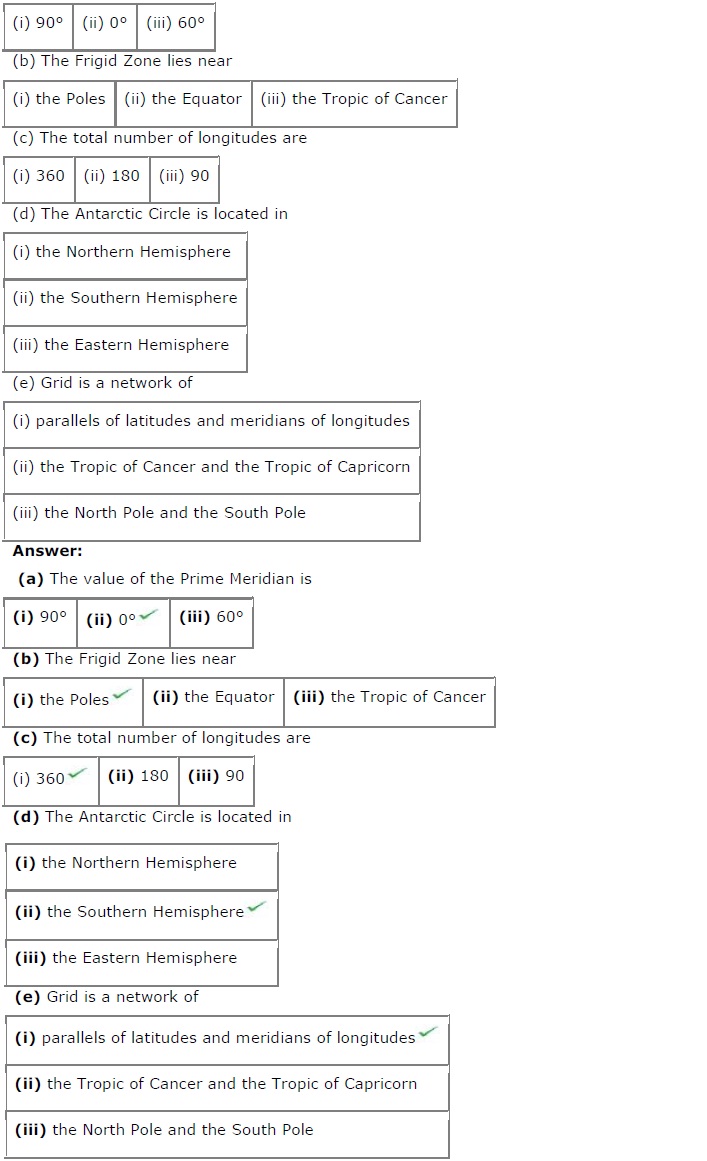Class 6 Social Science – Geography NCERT Text book Answers of Chapter 2. NCERT Solutions Class VI Social Science – Geography includes answers of all the questions of Globe Latitudes and Longitudes provided in NCERT Text Book which is prescribed for class 6 in schools.
National Council of Educational Research and Training (NCERT) Book Solutions for Class 6
Subject: Social Science – Geography
Chapter: Chapter 2 – Globe Latitudes and Longitudes
NCERT Solutions for Class 6th Social Science: Chapter 2 – Globe Latitudes and Longitudes
Class 6 Social Science (Geography) Chapter 2 Globe Latitudes and Longitudes NCERT Solution is given below.
Question 1:
Answer the following questions briefly.
(a) What is the true shape of the Earth?
(b) What is a globe?
(c) What is the latitudinal value of the Tropic of Cancer?
(d) What are the three heat zones of the Earth?
(e) What are the parallels of latitude and meridians of longitudes?
(f) Why does the Torrid Zone receive maximum amount of heat?
(g) Why is it 5.30 P.M. in India and 12.00 noon in London?
Answer:
(a) Earth is slightly flattened at the North and South Poles, and bulges in the middle. The shape of the Earth is described as a ‘geoid’, that is, ‘an Earth-like shape’.
(b) Globe is a true model (miniature form) of the Earth.
(c) The Tropic of Cancer lies 23½ ° north of the Equator.
(d) The three heat zones of the Earth are: the Torrid Zone, the Temperate Zone and the Frigid Zone.
(e) All parallel circles from the Equator up to the Poles are called parallels of latitudes.
The lines of references running from the North Pole to the South Pole are called meridians of longitudes.
(f) The area between the Tropic of Cancer and the Tropic of Capricorn is known as the Torrid Zone. The mid-day Sun is exactly overhead at least once a year on all the latitudes in this area; hence, this area receives maximum amount of heat.
(g) In London, the Greenwich Mean Time (GMT) is followed. The Indian Standard Meridian is located 82½° east of the Prime Meridian. Thus the Indian Standard Time (IST) is 5 hours and 30 minutes ahead of GMT. So, when it is 12 noon in London, it
is 5.30 P.M. in India.
Question 2:
Tick the correct answers.
(a) The value of the Prime Meridian is

Question 3:
Fill in the blanks.
(a) The Tropic of Capricorn is located at __________.
(b) The Standard Meridian of India is _________.
(c) The 0° Meridian is also known as __________.
(d) The distance between the longitudes decreases towards _________.
(e) The Arctic Circle is located in the _________ Hemisphere.
Answer:
(a) The Tropic of Capricorn is located at 23½° south of the Equator.
(b) The Standard Meridian of India is 82½° E.
(c) The 0° Meridian is also known as the Prime Meridian.
(d) The distance between the longitudes decreases towards the Poles.
(e) The Arctic Circle is located in the Northern Hemisphere.